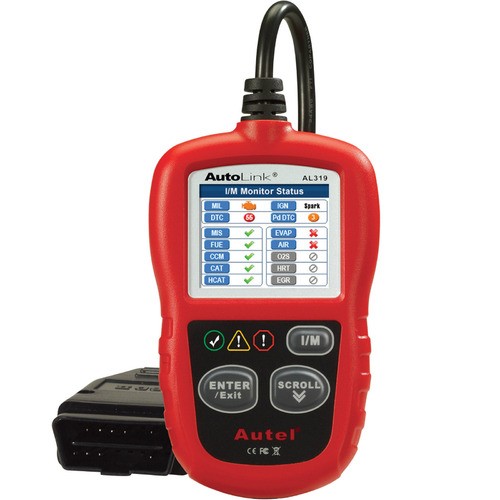Navigating the world of car diagnostics can be overwhelming, especially when you’re faced with a dashboard illuminated by the dreaded check engine light. Understanding the Types Of Obd2 Scanners available is the first step in taking control of your vehicle’s health. With a plethora of options on the market, ranging in price and functionality, it’s crucial to identify the best OBD scan tool that aligns with your specific needs. This guide will break down the different categories of OBD2 scanners, empowering you to make an informed decision before you buy. For further assistance in your selection process, we also recommend checking out 5 Essential Steps To Consider Before Buying an OBD Scanner.
The most crucial step in purchasing an OBD scan tool is determining your requirements. Are you a car owner looking to understand and resolve basic issues at home? Or are you a professional mechanic needing advanced diagnostic and programming capabilities for your workshop? Your needs will dictate the type of OBD2 scanner that is most suitable. Factors such as car coverage, desired features, and functionalities all play a vital role in this decision. Remember, the most expensive scanner isn’t always the best choice for everyone.
Before diving into the types, it’s important to verify your vehicle’s OBD compatibility. While most modern cars have the standard 16-pin OBD port, it’s not a guaranteed indicator of OBD2 compliance, especially for older models. Consult our OBD2 Australia Compatibility List or, if your car is newer than 2012 and not on the list, it is likely OBD2 compatible.
Let’s explore the main types of OBD2 scanners available:
1. Engine OBD2 Code Readers
Engine code readers are the entry point into OBD2 diagnostics. These basic OBD2 scanners are designed to specifically address engine-related issues. Their primary function is to read and interpret engine trouble codes, helping you understand why your check engine light is activated. These tools empower you to diagnose engine system faults, clear fault codes, and reset the check engine light.
When choosing an engine code reader, factors to consider include price, brand reputation, and the inclusion of enhanced Mode 6 features. Mode 6 capability allows for more in-depth testing, including fuel and emission system health checks and oxygen sensor tests.
2. Bluetooth/WiFi OBD2 Scanners for Smartphones
For users who prefer a wireless and mobile approach, Bluetooth and WiFi OBD2 scanners offer a convenient solution. These scanners establish a wireless connection between your car’s computer and your smartphone (Android or iPhone) via the OBD2 port. The functionality and performance of these scanners vary based on device compatibility, connection type (Bluetooth or WiFi), compatible mobile apps, and data transfer speed.
The product range includes basic Bluetooth/WiFi OBD2 engine scanners to more specialized devices like AFR wideband smartphone gauges and battery testers/monitors. Generally, these scanners excel at real-time monitoring of various diagnostic parameters and trip data. For diagnostic capabilities, most apps primarily focus on engine diagnostics unless specifically advertised as multi-system or bi-directional.
Shop WiFi & Bluetooth OBD2 Scanners
3. OBD2 Gauges & Monitors
OBD2 gauges and monitors take real-time data display a step further. While similar in basic functionality to engine code readers, they present OBD2 data as live gauges directly in your vehicle. Instead of relying on a separate handheld device, these tools continuously display crucial parameters.
Popular among drivers who want to actively monitor their car’s vital signs, OBD2 gauges can display temperature readings, pressure sensors, speed, fuel consumption, and trip statistics. They offer a practical way to leverage OBD2 data for enhanced driving awareness, promoting safer and more efficient vehicle operation.
Shop OBD2 Gauges & Monitors
4. Multi-System OBD Scan Tools
Moving beyond engine-only diagnostics, multi-system OBD scan tools provide a more comprehensive diagnostic approach. These scanners extend their capabilities to diagnose various vehicle systems beyond the engine, including ABS, SRS (airbag system), body control modules, transmission, and more.
The system coverage can vary depending on the specific scan tool, ranging from a selection of systems to full system diagnostics. Some tools cater specifically to OBD2 vehicles, while others offer broader compatibility including older OBD1 vehicles. Certain multi-system scanners also include specialized functions for heavy diesel vehicles and additional service reset features like oil service resets, steering angle sensor (SAS) resets, and diesel particulate filter (DPF) regeneration. If you require these service functions, ensure you filter your options accordingly.
Shop Multi System OBD Scan Tools
5. Single-Make OBD Scan Tools
For professionals or enthusiasts specializing in particular car brands, single-make OBD scan tools offer a focused and powerful diagnostic solution. These tools are designed to provide in-depth diagnostics and comprehensive functionality comparable to professional-grade scanners but are tailored to one or a limited number of car brands (typically 1 to 5).
Single-make scanners provide efficient and effective diagnostics, granting access to most vehicle systems and essential service/reset functions within their brand focus. They represent a cost-effective alternative to investing in all-car scanners, making them ideal for specialized workshops, dealerships, and individuals who primarily work with specific car brands.
Shop Single Brand OBD Scan Tools
6. Professional OBD Scan Tools
Professional OBD scan tools represent the pinnacle of diagnostic capability. Designed for workshops and experienced mechanics, these scanners offer comprehensive diagnostic coverage across a wide range of vehicle makes and models, particularly within the Australian market. They boast advanced bi-directional controls, coding, and programming functions.
Professional scanners often incorporate additional hardware features that further enhance their diagnostic prowess. These features can include online databases and support, client management systems, integrated automotive oscilloscopes, and faster scan processing times, making them indispensable tools for demanding professional environments.
Shop Professional OBD Scan Tools
7. Service Reset OBD Scan Tools
Service reset OBD scan tools are specifically engineered to perform advanced maintenance and service functions on a wide array of vehicles. Beyond basic code reading, these tools excel in executing essential service procedures.
Common service functions include oil service and mileage interval resets, electronic parking brake (EPB) service, brake bleeding, battery replacement and programming, tire pressure monitoring system (TPMS) functions, throttle body alignment, immobilizer functions, DPF regeneration, and many others. These tools streamline routine maintenance and repair tasks.
8. OBD1 to OBD2 Cable Adapters
OBD1 to OBD2 cable adapters serve as bridge connectors for older vehicles. These adapters facilitate the connection of your OBD2 scanner to vehicles equipped with manufacturer-specific OBD ports (OBD1), which predate the standardized OBD2 port.
It’s crucial to understand that these adapters are simply physical connectors. While they enable physical connection, the OBD2 scanner itself must still be compatible with the diagnostic protocols used by the older vehicle to effectively read data.
Shop OBD1 to OBD2 Cable Adapters
This overview provides a solid foundation for understanding the diverse types of OBD2 scanners available. Remember that within each category, scanners will vary in compatibility, features, and functions. If you require further assistance in selecting the ideal OBD scan tool for your specific needs, please contact our support team for personalized guidance.

